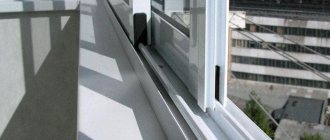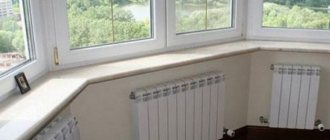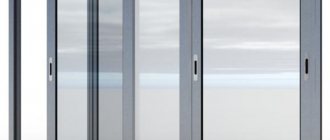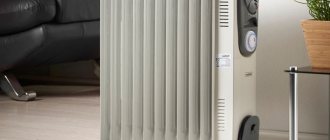What to consider when choosing a heater for a balcony
Balcony heating. Which heater to choose?
A heating device is selected not only based on the characteristics of the device itself, but also taking into account the specific use of the room. Options for using a balcony:
- Pantry or utility room. Maintaining a temperature of about 3-5 degrees is enough. You can do without heating devices, just by insulating it well.
- Work office, place to relax. Heating will do as needed.
- A living space, a place to sleep, or an area combined with a living room or kitchen. In this case, it is necessary to constantly maintain a temperature of about 20-25 degrees.
That is, if you have a glazed balcony and it is used, for example, for drying clothes or simply for storing things, then it is not necessary to heat it. But if you will regularly use it as a living space, then at a minimum you will need a wall or ceiling heater. But it’s even better to install infrared heated floors. You can read about their benefits in this article.
A heater for a loggia or balcony must meet four basic requirements:
- Be safe. Must have fire/overheat protection (automatic shutdown of the device when overheated or tipped over).
- Be economical. Have a thermostat that allows you to automatically maintain the desired temperature.
- Have the power necessary to warm up your balcony (based on the size and degree of insulation of the balcony).
- Occupy a minimum of usable space.
In accordance with these conditions, the following types of heaters are suitable for heating a balcony or loggia:
- electric radiators;
- floor and wall fan heaters;
- ceiling or wall IR (infrared) heaters;
- electric heated floors.
From our experience, oil and gas heaters are definitely not suitable for heating balconies due to their fire hazard.
Gas heater
Oil heater
Let's take a closer look at the main options.
Power of devices for heating balconies
In an attempt to understand which heater for a balcony or loggia is better, consumers forget about the power of the device, which determines how efficiently the entire area of the room will be heated. To do this, you need to determine the number of cubic meters and the level of heat loss:
- High degree of thermal insulation per 1 m 3 – 20 W
- Average degree of thermal insulation per 1 m3 – 30-40 W
- Low degree of thermal insulation per 1 m3 – 50 W
Power calculation is carried out as follows:
Balcony area, m2 * ceiling height, m * degree of insulation, W
For example, a loggia with an average degree of thermal insulation with an area of 14 square meters. m with a ceiling height of 2.8 m: 14*3*30 = 1260 W
The performance of the device must be no lower than the calculated indicator. It is worth noting that insulating a balcony or loggia will help reduce this figure.
If you have any difficulties with calculations, contact a specialist for help
Electric radiators for heating a balcony or loggia
They can be classified as the safest and easiest to install devices for heating a balcony. Almost all electric radiators have thermostats that allow you to set a comfortable temperature. In some cases, thermostats have to be purchased separately, but, as a rule, the seller warns about this in advance. The power of one radiator usually varies from 500 W to 2 kW.
Electric radiator
The advantages of the radiator are:
- safety;
- low price;
- almost always a built-in thermostat;
- easy installation;
- Possibility of installation after complete finishing.
Modern models do not dry out the air, are suitable for heating small balconies and can be used both on an ongoing basis and as needed.
The disadvantages of a radiator for heating your balcony or loggia are:
- heat spreads unevenly;
Electric radiator - 2 - poor floor heating;
- occupies a power socket.
Another significant disadvantage of using electrical appliances for heating is the significant consumption of electricity.
Note:
pay attention to the installation location. Place the radiator on a solid wall. When installing on an insulated wall, it is necessary to take into account where the hidden sheathing is located, since it must be mounted to it. When installing an electric convector yourself, you should also pay attention to the length of the wire and the distance from the outlet.
Water heated floor heating loggia
How to heat a loggia? You can install a modern system with the established name warm floor. The options include both electric heated floors and water heated floors. Very often the choice leans towards the second option.
Water floor installation:
- First, a concrete screed is laid;
- Then the concrete screed is leveled;
- Then the insulating material is laid;
- Then plastic pipes are laid, the basis of the heated floor system, the pipes are laid in a snake pattern, at a relatively short distance from the bends;
- Plastic pipes are connected to the hot water supply system;
- Then the concrete screed is laid again.
Heating is carried out using hot water. The disadvantage of this method is that the process is labor intensive. The same electric heated floor will be easier to install.
Floor and wall fan heaters for heating balconies
An interesting option for quickly heating the air on the balcony is a floor or wall fan heater. It is suitable if you want to spend an evening there with friends. The fan heater will warm up the balcony very quickly.
Floor fan heater
Advantages of heating a balcony with a fan heater:
- rapid heating of indoor air;
- fairly simple installation of wall-mounted models;
- Floor-standing models do not require installation. The heater can be removed at any time;
- uniform heating of the premises (except for the place where the fan heater is directly installed);
- the presence of a thermostat and stepwise power adjustment. This greatly expands the functionality of the heater.
The disadvantages of fan heaters include:
- low efficiency.
Electricity consumption is higher than when using other devices; Wall fan heater - wall-mounted options must be mounted above head level and require a socket at a height;
- When the fan is running, there is sometimes a slight odor;
- increased noise relative to other heating sources;
- poor floor heating;
- It is not comfortable to be near a wall-mounted fan heater (closer than 1 meter) due to the high air temperature. This can be a problem for rooms with a small area.
Summarize
: a fan heater is a good option, but not for constant heating, but specifically for quick
periodic
heating of a balcony or loggia. Mount it, just like an electric convector, preferably on a solid wall. If the wall is with insulation, then in the mortgages (sheathing).
What to consider when transferring
The first and main obstacle to such a solution is the Housing Code of the Russian Federation, which categorically prohibits the transfer of utility lines, including heating radiators, to balconies and loggias. In very rare cases, it is possible to obtain official legal permission for such redevelopment in apartment buildings. But owners of private houses can carry out this type of work completely calmly.
The second important factor that must be taken into account is the condition of the external walls. It makes sense to install any heating system in well-insulated areas, otherwise no method will be effective. In addition, if the wall freezes, then there is a high probability of water freezing and a radiator breakthrough. The consequences are not only a fine for illegal redevelopment, but also payment for repairs to the apartments located below.
Infrared ceiling or wall heaters
This type of heater is placed on the walls and ceiling. Their operating principle is based on infrared waves. They heat nearby objects, which, in turn, heat the air.
Infrared wall heater
Advantages of using infrared heaters on the balcony:
- — uniform heating of the room;
- - efficiency;
- - high efficiency.
Infrared ceiling heater
Features of using infrared ceiling and wall heaters for balconies:
- strong dependence of surface heating on the distance to the heater;
- not suitable for balconies with a small area, rather suitable for terraces;
- it is better to choose extended low-power options;
- Models with power control have an advantage (for example, with a 0.5 and 1 kW switch);
- the heater housing often becomes very hot;
- sockets or connected wire to the installation site are required;
- it is often non-rotating, i.e. it will not be possible to direct it to another part of the balcony;
- heating feels like solar heat;
- there is no need to heat the entire balcony; you can almost instantly begin to warm up any area, for example, a workplace.
How to heat a balcony in winter: popular options
Before installing heating on the balcony, it is necessary to finish it and insulate it. How to make it suitable for living all year round? You can use one of seven options.
Traditional steam heating
Installing an additional battery for a balcony or loggia is a great idea, because this method is simpler than others and has no equal in terms of efficiency. But there is a big disadvantage - this is the possibility of encountering legal problems. The fact is that removing the battery will probably be illegal. It is futile to hope that no one will notice anything.
When one of the residents of an apartment building has an individual battery on the balcony, residents of neighboring apartments may feel a decrease in heat transfer from their own radiators. The reason lies in the design features of central heating. However, this method should not be written off prematurely. Such issues are discussed with housing and communal services employees - with their help you can obtain the necessary permission.
Electric heating
The balcony heater can also operate using electricity. This is equipment such as a convector or oil heater. Easy to install, it is ideal because it can be turned on and off as needed. But there are also significant disadvantages. The first and main one is an increase in energy costs.
The second drawback is the unpleasant odor that appears due to low air humidity in such a small room as a loggia or balcony. It is enough to install an air humidifier in a heated balcony to prevent this from happening. The third disadvantage is the increased fire hazard. Installing an oil heater is justified where they do not spend too much time on the loggia.
Infrared heating
A rather innovative way to make a balcony or loggia warm is with ceiling and wall infrared panels.
The effect of infrared heat on the surrounding space is similar in its properties to sunlight. Modern infrared heaters for the balcony will not only make it suitable for permanent use in winter, but will also have a very positive effect on the walls and floor.
Infrared light will prevent condensation from accumulating on the walls and prevent the possibility of mold or mildew.
This is one of the cleanest methods of heating a loggia from an environmental point of view. In addition, it is very economical.
But the installation itself cannot be called cheap. In addition, if the loggia is large, then the infrared heater may not be able to adequately heat the room.
Warm floor
If you want to include floor heating in your loggia heating, then this option is best suited. There is just one important point: the heated floor is laid before pouring the concrete screed. Read more about this method here.
If the balcony is small, then one heated floor is enough to heat the entire room. The method is good for its effectiveness, but difficult to install. There is also some fire hazard (for the electric type).
Warm baseboard
This is a modern balcony heating that came to us recently from European countries. It is installed instead of a regular baseboard, but has a heat exchange heating module inside. Usually these are two copper tubes with brass lamellas. This type of balcony heating includes a distribution manifold, from which the coolant is supplied to the heater. Like the floor, a warm baseboard can be powered by electricity or water.
Solar panels
Solar panels for apartment heating have appeared quite recently. Heating on the loggia using solar energy is convenient for owners of private houses. It is problematic to implement this in a city high-rise building, but it is possible. But still, a solar battery on an ordinary balcony is a rare occurrence. In the Russian climate, the option of such heating is, of course, controversial.
In addition, this is one of the most expensive ways to heat a balcony - it all depends on the cost of solar panels. The solar battery itself on your balcony will not create a warm atmosphere: it only collects solar heat, which is converted into electricity through a special device. The electricity can then be used to power a heater.
The principle of operation of a solar battery
Ceramic heaters
You can also use ceramic heating panels to heat your balcony.
Ceramic heater
They consist of the following components:
- magnesite plate;
- metal body coated with polymer materials;
- a heating element;
- ceramics.
75% of the heat is given off by the ceramic surface in the form of infrared radiation. 25% of the heat is the warm flow rising from the device. The panel and metal case can heat up to 90 degrees.
Ceramic heaters use the principle of propagation of infrared rays in combination with convection.
Advantages:
- relatively small size;
Ceramic heating panel
- efficiency up to 99%;
- simple installation;
- reduction in energy costs by 25-30% when using temperature controllers;
- compliance with environmental and fire safety requirements;
- does not dry out the air.
Disadvantages of ceramic heaters:
- High price;
- Strong heating of some models;
- Weight of some models;
- Insufficient heating in the area of the feet.
Which heater is best for a balcony?
Based on reasonable considerations, you can install an electrical device on the loggia without any problems. There is not even any prohibition if you want to install a heated floor from special mats powered by electricity. However, even among electric heating devices, you need to be able to choose the optimally suitable model.
Fan heater on the balcony
If the loggia is rarely used, there is no point in heating it constantly. No one needs extra energy consumption. For such cases, a fan heater is suitable.
The versatility of the fan heater lies in the availability of hot and cold air supply modes
The principle of the device is simple. A heating element in the form of a spiral is installed inside the housing. There is a fan in the background. The controls are a thermostat and a mode switch. A running fan blows on the hot coil. The heated air flows into the room. In summer, you can turn off the heater using a switch. The device is used instead of a conventional fan to escape the heat.
Advice! For constant heating of a balcony, a fan heater is a bad choice. It is not capable of working for a long time and requires manual control.
Oil heater on the balcony
In second place in terms of simplicity of design and control is the oil heating device. Outwardly, it resembles a sectional battery. The coolant is oil. Heating is carried out by an electric heating element. Typically, most models have two heating elements. They can work individually or in pairs, and are turned on using buttons on the control panel.
The oil heater is able to operate autonomously
For ease of movement, the appliance is equipped with wheels. The thermostat is responsible for automatic operation. When the set parameters are reached, the heating elements are automatically turned on and off.
Advice! The oil heating device is capable of operating autonomously, which allows it to be left unattended. However, the heater is not suitable for continuous operation. In addition, it consumes a lot of electricity.
Convector heater for balcony
In general terms, the design of a convector resembles a fan heater, but there are differences. The heating element is still the coil. Whether a fan is present or not, depends on the model. However, even without it, heating is effective. Everything is connected with the main difference - the design of the case. The convector is designed in such a way that cold air masses enter from below. They pass through the spiral and, already heated, through the grille in the upper part of the body enter the room.
The heat distribution of the convector occurs due to the convection of air masses
It is optimal to install a wall-mounted heater on a balcony, but there are also mobile models with legs. In any case, there must be free space around the housing for convection to occur. If the convector is used for constant heating, choose models with a thermostat and additional protection functions. These heaters are safe to leave unattended.
Advice! The convector dries the air and consumes a lot of electricity. A convector heater for a balcony cannot be called economical.
Ceramic heater for the balcony
A modern heating device is a ceramic heating panel. Essentially, this is a device that produces infrared radiation. The heater has a metal body with a polymer coating. Thermal ceramics are applied to the front side. There is a heating element located inside the housing. An infrared heater is installed on the balcony according to the principle of a radiator or convector - secured with brackets to the wall.
Ceramic IR heater heats objects falling into the field of action, not air, with a heat flux
Heating a room with a ceramic device occurs in combination:
- 25% of the heat is radiated due to convection of air masses.
- 75% of heating is provided by infrared heat flow.
Due to this operation, the efficiency of the electrical appliance reaches 99%. Since IR radiation does not heat the air, it does not dry it out. Heat spreads from objects heated by infrared rays. The advantage is energy savings of up to 30%. The heaters are able to operate autonomously without supervision throughout the winter season.
Advice! Ceramic electric heaters with automation and protection functions are expensive and less durable compared to carbon IR models.
Infrared heater for loggia
In addition to the considered ceramic IR electric heater, there are other models. The most reliable and safest for health are devices with a carbon and tubular heating element. Due to its high power, it is reasonable to install a carbon heater on a balcony if it has a larger area, but this option is rarely available for apartment buildings. It is optimal to limit yourself to a tubular model. You should immediately discard the halogen IR device, since its radiation has a harmful effect on humans.
Among IR electric heaters, it is optimal to choose models with a tubular heater for a balcony
Install the IR heater on the balcony so that the radiation of the heat flow from it spreads throughout the entire room as much as possible. Here you need to think about which model is best suited: ceiling, wall or floor. The fewer obstacles on the way, the better the heating occurs.
Advice! Carbon and tubular heaters can even be used to temporarily heat an unglazed balcony.
Quartz heaters
There are monolithic and infrared. The difference lies in their structure:
- for monolithic ones, the heating panel is made from quartz;
- In infrared heaters, quartz is the material for heating pipes.
Heating is carried out by a nichrome thread built into the panels or quartz tubes. Heated quartz emits infrared heat, heating nearby objects.
Quartz heater
Advantages of monolithic quartz heaters:
- affordable price;
- design in which there is nothing superfluous;
- no noise during operation;
- health safety;
- heating the room does not take much time.
Disadvantages of monolithic quartz heaters:
- ceramics weigh a lot;
- it is necessary to additionally purchase a thermostat;
- a protective screen is required to avoid getting burned on the panel;
- ceramics is a fragile material.
Quartz infrared heater
Advantages of quartz infrared heaters:
- Safe - all heating elements are located behind a durable grille, and the device also turns off automatically when tipped over;
- Silent – can be installed directly in recreation areas;
- Compact and mobile - does not require installation, and can be removed if necessary;
- Durable – if used carefully, the heater will serve you for a very long time;
- Economical - there is a timer and temperature regulator. Disadvantages of quartz infrared heaters:
- Uneven temperature distribution - such a unit does not heat the air, but only the objects it is directed at; accordingly, if the heater is directed at you at the level of your feet, then at the level of your head you will be cold;
- Some elements get very hot, and if you are careless, you can get burned;
- The fragility of the vacuum quartz flask - if damaged, it is almost impossible to repair it;
- The room cools down quickly.
Modern heating infrared heater for the balcony
But, fortunately, in addition to steam heating, there are modern worthy alternatives. You can install a heated floor system or install an infrared heater on the balcony. In the latter case we are talking about a carbon heater.
Infrared heaters are:
Is such a heater dangerous in an apartment, much less a balcony? Infrared rays, one might say, do not have those characteristics that can negatively affect human health. They will also not harm animals and plants. They do not create noise or vibration, and do not burn oxygen like some other heaters.
It is even believed that this type of radiation allows the creation of molecules in the air, called anions. It is believed that they purify the air and have a positive effect on all living things. An IR heater will save 20 percent on electricity consumption. You can also install a programmable thermostat. And then you can save electricity by 35%.
Electric heated floors for a balcony or loggia
Perhaps this option is the best for heating balconies and loggias. Electric underfloor heating is ideal for maintaining a comfortable room temperature.
Its obvious advantages: careful consumption of energy, uniform heating of the entire area, ease of installation, protection against mold, and electric heated floors do not take up any space.
Good to know: the power of underfloor heating is calculated based on the power per square meter. This means that 1 square meter of heated floors from different models and manufacturers can heat in completely different ways.
Main types of electric heated floors:
- Heating cable mounted in a screed.
- Heating mat for floor tiles.
- Infrared film flooring for laminate or linoleum.
Heating cable in screed
Heating cable in screed
An undoubted advantage of laying a heating cable is economical energy consumption. It is placed in a screed, thanks to which the floor retains heat longer. You can also regulate the required heat supply power by laying one or another (suitable for you) amount of cable per square meter.
The disadvantages include the fact that it heats the floor for quite a long time, so it is not suitable for short-term use.
A special electric cable is used as a heating element. It is necessary to first prepare the base, make thermal and waterproofing.
Heating cable laying diagram
Stages of work:
- Preparing the floor for laying tiles (screed, DSP sheets on joists, etc.) is often dusty and long (more than 2 days) work.
- Electrical cable connection.
- After this, at the time of laying the floor tiles, the mats are laid.
The main advantages of using a heating cable for underfloor heating in a screed:
- the air in the room warms up evenly;
- you can walk barefoot without fear of catching a cold;
- The heating is based on the principle of the Russian stove;
- A properly laid heating cable has a long service life.
It is also worth noting some disadvantages of laying the heating cable in a screed:
- the room takes a long time to heat up;
- installation takes a long time due to the long drying time of the screed;
- the screed increases the height of the floor;
- Not all balconies can be screeded;
- The topcoat can only be tiles (not linoleum or laminate).
Despite the long heating time, such a floor remains warm for a long time even when turned off. Electric cable tie is ideal for use in large spaces.
Heating mat under tiles
A heating mat for a balcony is actually the same heating cable, only attached to a mesh, which eliminates the need for additional calculations of power per m2. It is the heating mats that do not have to be laid in the screed before laying the tiles. They are laid directly during the work of tiling the floor with ceramic tiles.
Heating mat under tiles
Sequence of work:
- Preparing the base for laying tiles (pouring screed, CBPB sheets, etc.).
- Electrical cable connection.
- Laying mats under floor tiles.
Advantages of a heating mat under tiles:
- heats the floor faster than a heating cable;
- easier to install;
- a well-laid floor does not require maintenance and can last for decades;
- less afraid of the “locking effect” (laying under furniture) than an infrared floor.
Disadvantages of mats for tiles:
- not suitable as the only way to heat a balcony at temperatures below -10 degrees. An additional heat source may be required to maintain the desired temperature. But in any case, even in the absence of one, a warm floor will not allow the room temperature to drop below -5-10 degrees;
- The efficiency of underfloor heating on a balcony depends very much on the type of glazing and insulation of the balcony. However, there are many examples where a heated floor with an area of 3 sq. m. enough to warm up the entire balcony in the most severe (by St. Petersburg standards) frosts;
- repair or replacement without dismantling the tiles is impossible;
- at particularly low temperatures, it is necessary to install hidden wiring and a wall thermostat.
Heating mat under tiles – 2
Despite the complexity of installation on a balcony, we still consider warm floors a necessary condition for comfort. Lower energy efficiency (in the short term) means that you won’t be able to turn on the floor and heat the balcony in a few hours. But when the tile warms up, the heating effect will feel similar to the heat coming from a Russian stove.
Infrared heated floor on the balcony
Infrared heated floor on the balcony
The main advantage of using infrared flooring is the possibility of its compatibility with laminate or linoleum. These floor coverings are the most budget-friendly and are used most often. Therefore, infrared heated floors can be considered the most popular method of heating insulated balconies and loggias. Also, such a floor ionizes the air, which eliminates allergens and unpleasant odors (paint, tobacco, etc.).
Infrared rays heat nearby objects, which transfer heat to the entire room.
8 reasons to install film infrared heated floors on the balcony:
- Easy installation.
- No expensive surface preparation required.
- Does not put a load on the balcony, as is the case with pouring screed.
- Infrared film flooring is safe for health.
- During heating, air ionization occurs. This eliminates unpleasant and foreign odors in the room.
- For repairs, you only need to remove the laminate or linoleum.
- If you need to add furniture to a balcony or loggia, high-quality floors make it easy to remove or add the required number of mats by connecting them to existing ones. To do this, you only need to remove the finishing floor covering.
- It doesn't take long to heat up.
Laying infrared heated floors on the balcony
When purchasing a heated floor, pay attention to the power of the mats. For glazed balconies and loggias, infrared mats with a power of more than 200 W per 1 sq. m. are best suited.
How to make heating on the balcony in other ways?
- Electrical appliances can heat the loggia, but for this you need to install electrical wiring. Installing wiring through openings is unsafe. It is better to lead the cable through a wooden window frame or wall by drilling a “channel”. The cable on the loggia must be laid in special plinths so that the wire is not damaged when rearranging furniture and other things, and does not stand out in the interior. The skirting board protects the wire from moisture, reducing the risk of short circuits.
- Warm floor for heating a balcony does not require installing an external heating device here, allows you to save space and regulate the temperature. Balcony rooms are usually heated with underfloor heating with electric cable. The wires are mounted on a concrete base, upon completion of installation they are filled with mortar, then a heat-conducting coating - tiles, linoleum - is laid on the hardened screed. Only the temperature regulator and the power cable are brought beyond the floor.
Thermal insulation helps to heat a room more efficiently. With it, heat is not lost to heating the ceiling on the lower floor. Thermal insulation can be foam sheets, mineral wool, expanded clay concrete. Manufacturers guarantee that heated floors on the balcony can be used for up to 10 years. But in most cases it is used for up to 30-50 years, maintaining functionality. - Convection devices (radiator and converter type) , various emitters. Considering the small space of a standard loggia, it is more rational to heat it with oil radiators. Their advantages are fire safety, they can provide optimal heating of a room with a low power of up to 2 kW. Unlike electric fireplaces and heating elements, which get very hot and burn oxygen, oil radiators heat up to +85 degrees and do not dry out the air. It is better to choose sectional radiators with oil. With the same value as flat ones, they have a larger heating area. As a rule, heating units are equipped with rollers and power switches.
When creating comfort and coziness in the apartment, take into account our recommendations on how to install heating on the balcony legally, and take care of the safety of your household and the thermal insulation of the loggia. Heating an insulated balcony is much more economical. Be more selective about balcony heating systems. Evaluate their effectiveness and necessity for your case.
This material is advisory in nature. Before making a final decision, consult with a lawyer.
conclusions
When choosing a method for heating a balcony, it is necessary to take into account many factors (purpose of the room, area, cost of the device, etc.). There are no bad or good options, since everything depends on specific conditions. Nevertheless, the most affordable and effective methods include infrared flooring.
If you are thinking about how to heat an insulated balcony and have questions, please contact us. We will offer you the option that best suits your requirements.
We are always in touch and ready to help. Call daily +7 (812) 407-35-00
With respect to you and your colleagues in the workshop.
Team "Your Home"
Additional video on the topic
A full range of works - from glazing and insulation to attaching the loggia to the room:
Main insulation mistakes:
Installation of film heated floors on the loggia:
Construction of a warm balcony and loggia is a technologically complex process that includes several key stages. Only trained craftsmen with a sufficient base of knowledge and tools can perform such turnkey work. Therefore, if you lack the necessary experience, and also do not want to spend money on correcting mistakes, entrust the installation of glazing, insulation and floor heating to professionals.











